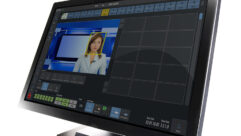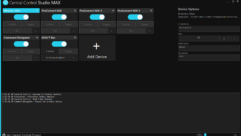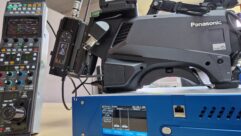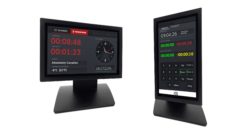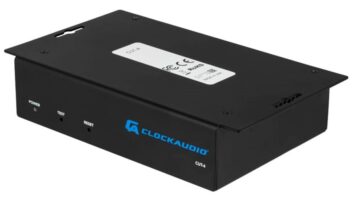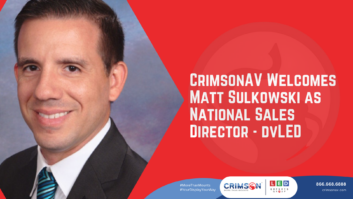On the SVC Podcast, Contributing Editor Bennett Liles talks with Rob Barton of McClelland Sound about the complete sound system installation in Kansas State University’s Mark Chapman Theatre. The centerpiece of the project was a Yamaha AFC3 active acoustics system. Rob details the design, planning and installation of this and much more sound gear to allow the venue to accommodate a wide range of events and seating arrangements.
HEAR MORE PODCASTS ON THE #svcpodcast PAGE
This is the SVC Podcast from Sound & Video Contractor Magazine with Rob Barton of McClelland Sound. For more information check out the show notes and product links for this podcast and others at svconline.com.
Yamaha’s AFC3 is the latest version of their variable acoustics system using Active Field Control. When Kansas State University renovated their Mark Chapman Theater they called in McClelland Sound from Wichita to install and commission it as part of an even bigger project. Rob Barton is here to let us know how it went. That’s coming up next right here on the SVC Podcast.
Rob, good to get you with us today for the SVC Podcast. We’ve had dueling schedules for a while now but we both got a chance for it today so it’s great we could do this one. Coming to us from Wichita, Kansas at McClelland Sound. This was a Yamaha AFC3 installation in the Mark Chapman Theatre at Kansas State University.
Yes.
I think this was part of a general renovation that was going on. Your outfit is certainly no newcomer to AV projects. There’s a mighty rich history there so give us some of the story on McClelland Sound.
The original original business was actually McClelland and Mogle and it started as kind of a partnership between two guys. And it started, oddly enough, revolving around Kansas State University. Originally it was building radios and McClelland and Mogle split off at one point and basically in 1928 was when we were really founded. So this is our 90 year in business and the third generation of family ownership. We currently employ about 20 people full time. We’re based out of Wichita, Kansas, but our sales territory is all of Kansas, all of Oklahoma, parts of Missouri, Nebraska and Colorado. We pretty well serve houses of worship, K-12, higher education, corporate, hospitality, government, industrial. And stuff that we normally engage in regularly are performing arts venues, of course – auditoriums, theaters – stadiums and arenas, cathedrals and church sanctuaries of sorts. We have done several casinos and of course we get calls for general paging and public address type stuff. So we pretty well cover the whole gamut. I think about 15 years ago when we started taking on video and control and five years ago or so when we started taking on theatrical type lighting and projects like that. So we’ve expanded to the whole AVL type gamut of sound, video, lighting control and acoustical design. [Timestamp: 2:53]
A lot of tradition there and that company has seen a lot of changes in technology over the years. Kansas State University called on you for a very comprehensive project at their Mark Chapman Theatre.
It was a very technical job, of course, and really required a lot of organization and a lot of coordination between theater staff and what the physical parameters were of the room. It was nice to be involved in it. We had done another theater of K State’s I think in 2015 or maybe 2016. And that one was actually a consultant designed project and they were so happy with the customer service they decided to cut out the middle man and directly hire us to do the sound remodel of this theater. It was a very long process starting in 2015 and working through different budgets and different fiscal years and all that fun stuff that the public sector has to go with. And finally a donor decided that they were tired of waiting and they wanted to make some things happen. So that was what really pushed the project forward and also allowed the small other remodel to happen as well. [Timestamp: 4:11]
And when the money’s there, go for it while you’ve got it. A Yamaha AFC3 variable acoustics system is what they wanted to deal with the very diverse needs of this flexible venue. They’ve got a huge variety of shows in this place with flexible seating and that required some pushbutton creativity on the acoustics.
The theater people, their big focus is not so much the reinforcement of the performers, but they do a lot of spatial effects in the theater and their need for that far exceeded any other theater that we had ever worked with. So the initial thought was okay, well, we could probably do some sort of fixed LCR over the three seating areas and give them a bunch of portable jacks and they could just plug whatever they needed wherever they needed and use the patch base, which they had been accustomed to since the 80’s, I think, when the original system was put in then. Then we started thinking about it some more and this is a really strange sounding room. The natural reverb time is maybe a half second, maybe 6/10 of a second and it just didn’t really feel like a theater or a traditional performing arts space where you would go in and just project unamplified. And so that’s when we thought of the variable acoustic type systems. There’s a lot of those on the market. And we decided Yamaha because it seemed to me that the system could be the most integrated through them as a manufacturer. And it also seemed like their hardware was much more up to today’s technical standards versus a lot of the competition that people are familiar with. [Timestamp: 5:59]
Yeah, I think I should have called you before all this happened and asked you to hold off till I could be some stock in Yamaha speakers. Let’s see, you’ve got a lot of them in here. I looks like 60 or so VSX8’s, IS1118 subs, of course Yamaha amps, Yamaha mixer. Seems like you had a little bit of a challenge on where to put the amplifiers.
The initial building, it was not a theater. I believe it was actually a gymnasium if memory serves me correct. And a million years ago it was lit on fire by an arsonist and sat vacant. They decided okay, we should tear this down and there was a big protest and decided okay, we can make some classrooms out of this and we can also make performing arts space out of this. So really the only thing original to the building was the exterior walls, but because they had to build it out within those confines they had to get very creative. So the room that all the hidden equipment – it’s physically under the seats and because of course the seats rake up the ceiling actually rakes up within this room. So on the low it’s about five feet tall and it slopes maybe to seven if you’re lucky, and maybe four foot by eight foot footprint. So there’s not a lot of room in there and with all of the new equipment it was literally going to become a pizza oven because we calculated around 20,000 BTU of heat with the new equipment being installed and they didn’t really like the idea of selling pizza at the theater. But I thought it would have been profitable. So they had to put in a split level. They had to do some electrical rework to get additional service in there. So now we’ve got 80 channels of amplifier and a 24 RU rack. In addition to that we’ve got the AFC head-ins and some network switches and UPS’s and things like that for power conditioning and another 24 RU rack. So it just barely fit in there and actually so much that they had to move the existing electrical panels to the outside of the wall of that room because, of course, you’ve got to be three feet away from electrical panel. And so they had to move it to the outside wall in order to meet code, so that’s how tight the room was. [Laughs] [Timestamp: 8:19]
And you installed the main house mixer as well. I think that was a QL5.
QL5, yeah. Doing the system Yamaha front to back really allowed for some very tight integration between any of the digital routings that we would be doing, the wireless mics that we would be doing, and made it really easy to support and monitor because the QL, as you know, when you add specific Dante devices they have profiles in there of a lot of common Dante devices such as the AFC equipment and the MRX7 and wireless microphones and things like that. So it really made the Dante routing easy if they need to change that on the fly with the console and allow for them to maintain physical patching to everything but do the virtual patching through Dante routes on the board to where if they want to do 3D effects of speakers it’s clearly labeled in there exactly what this direct output goes to so it made it really easy for them to operate after the installation. Any time there is a spatial effect or a locational sound within the theater they’re easily able to decide where that goes and intuitively get it from Point A to Point B. [Timestamp: 9:36]
One of my favorite features on the whole QL Series is the integrated Dugan automixing. I loved when they put that in those. I just thought it was not just something tacked on but incredibly useful and from the most solid name.
Yeah. It really opened up the possibilities of the console format mixers and the ability to maintain a low number of open microphones so that you could increase the headroom that you’re able to get out of the system and not run into feedback problems. And of course with the theater there are a lot of times you might have 24 headsets on performers and a stage full of performers, but it’s very rare that all 24 people are going to be talking at the same time. So of course the people of the past would maybe try to actually gate them on a digital console and the dynamic range of the theater really doesn’t allow for standard dynamics processing, at least in the gate world, because sometimes things are whisper quiet but you don’t want to lose that reinforcement out of the system. And then of course other times they’re singing and a lot of those guys, they know how to project and they can really wail. So dynamic range of things in the theater needs to be really solid and allow for very flexible inputs. And I think the automixing really solves a lot of problems that a lot of digital consoles had in terms of flexibility and allowing some automation of your open microphones, especially when you’ve got things like dialogue and speech between performers on stage. [Timestamp: 11:15]
Really saves the day in unscripted formats. Now with this complex a system how did you manage not to exceed the existing equipment’s routing capacity?
That was not so much the Achilles heel, but that was something that was always, always on our minds. We had a really, really elaborate spreadsheet [Laughs] because obviously putting a Dante network in CAD is not terribly straightforward. So in this system we have around 240 Dante inputs and 320 Dante outputs. So we made a spreadsheet and put formulas in there and conditions in there to where everything would get nice, pretty colors and things like that. That way we would know that if we duplicated two inputs to a single output or if we exceeded the actual chipset’s capacity, you know some of them are 64 channels, some of them are 16 channels. So if we exceeded the chipset’s capacity the whole device within the spreadsheet would go red and we could try to reroute things through other summing buses and things like that to where we could stay very organized and be very diligent with the hardware limitations that are in place. And I would say we are generally at around a 95 percent limit of what the hardware will handle as installed, but the good news is that if they decide that they need to do something in the future and they need to exceed, in a lot of cases, that 64 channel limit there’s still plenty of card slots and things like that available so they can add new cards. And if technology changes and they need a different digital audio bus it’s pretty safe to assume that Yamaha will come out with a card slot for that and allow them to expand well into the future. [Timestamp: 13:07]
Another big advantage in staying with the same manufacturer through the job when it comes to futureproofing everything. Next week we’ll get into more detail on the mics, intercom and control system at Kansas State University’s Chapman Theatre. It’s Rob Barton with McClelland Sound in Wichita. Looking forward to hearing some more about it.
Thank you very much, Bennett. I appreciate your time.
Glad to have Rob Barton with us today. Next week Rob will tell us about the Clearcom communication, the Extron control system, microphones, RF mic antenna installation and the Yamaha QL5 main house mixer they chose for the Chapman Theatre. Get back with Rob and me for all of that on the next SVC Podcast.


